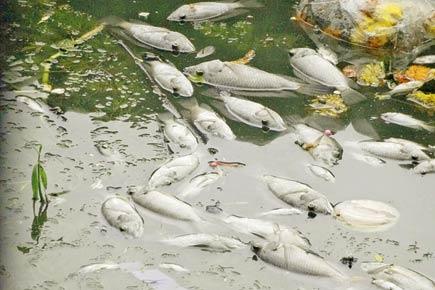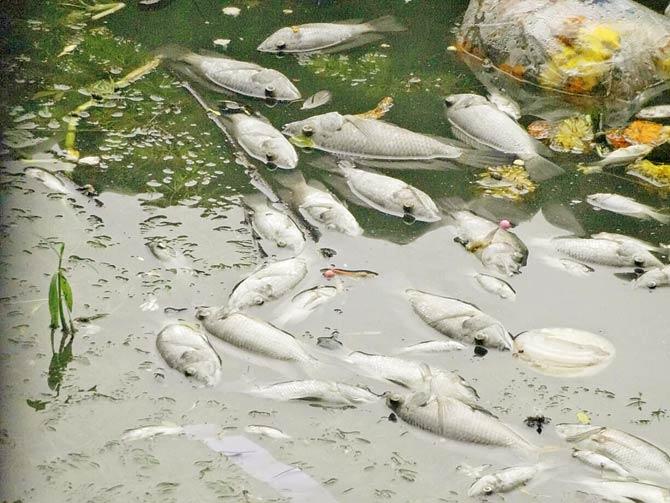Locals and experts blame it on the pollution from the immersion of Plaster of Paris idols, chemicals in paints used, and offerings; demand that BMC levy a penalty on mandals for the mess

 The fish carcasses are seen floating in the Kandivli pond, where they have already started rotting and emitting a nasty stench
The fish carcasses are seen floating in the Kandivli pond, where they have already started rotting and emitting a nasty stench
For humans, the Ganpati festival is a harbinger of good times and celebrations. But for the creatures living in the sea and the city’s rivers and ponds, the festival ends in death. This year too, over 300 fish have died after the Kandivli pond they call home was choked with Ganpati idols and nirmalya (offerings) from the recent visarjan.
ADVERTISEMENT
Raising a stink
The residents have made several complaints to the BMC about the pond in Kandivli village, but the authorities are yet to take any steps to clean the water and determine what caused the death of the fish. Now, the dead fish have started rotting in the water and raising an unbearable stench in the vicinity.
It was one of the local residents, Russell Daniel, who first spotted the floating carcasses of the fish on Sunday, while he was passing by the pond near Kandivli village, near the Shri Shiv Shankar temple.
“After the Ganapati immersion, I was shocked to see that there were many dead fish floating in the water, and despite repeated complaints, the BMC is not taking any notice of it. The fish have started stinking and this is causing a lot of problems. I respect every religion, but my only request to people is that they should start bringing environment-friendly idols and carry out the immersion in the many immersion tanks that the BMC builds specially for the visarjan.”
Two-fold damage
Locals believe that the fish probably died because of the pollution that took place because of the immersion of Plaster of Paris (PoP) idols and the chemical colours used to paint them. Another major factor for water pollution is the nirmalya – offerings such as flowers, coconuts and sweets.
Dr Vinay Deshmukh, retired principal scientist at the Central Marine Fisheries Research Institute (CMFRI), said, “I am quite sure the fish died because of both toxic pigments that are used in the paints, as well as high bacterial load from the decomposing organic matter such as flowers, prasad and other offerings. The bacteria then consume the dissolved oxygen in water, and the fish die because there isn’t enough oxygen left for them. Even the paints used on the idols contain metals such as chromium, lead, aluminium and copper, which dissolve and turn into toxic compounds in the water causing irritation and damage to fish gills.”
The issue of pollution in and around water bodies due to religious festivals has long been a source of concern for nature and wildlife enthusiasts. While this impact is diluted in the sea because of the sheer quantity of the water, the bigger problem is the amount of garbage that piles up on the beaches post visarjan. This time around, according to BMC, nothing less than 1080 tonnes of garbage were collected from beaches at the end of the festival.
Year after year, aquatic life takes a hit because of this – there have also been several cases in the past when hundreds of fish have perished at Banganga for the same reason. Activists have pointed out that this loss of life is entirely unnecessary, since the BMC has built several tanks across the city where devotees can immerse the idols and nirmalya without causing any ecological harm.
Penalty on mandals?
The activists further claim that every year, the BMC and NGOs come together to clean the mess at the beaches and lakes, but the Ganpati mandals do little to help. They are of the opinion that the civic body should levy a cess on mandals that create such pollution.
“Why is BMC not charging the mandals for creating garbage? They collect donations in lakhs. Why should they spend citizens’ money to do such damage?” questioned AV Shenoy, member of the Mumbai Transport Forum.
BMC Ward Officer Sahebrao Gaikwad was not available for comment despite several attempts. However, Vijay Balamwar, Deputy Municipal Commissioner (Solid Waste Management) said, “As far as levying cess is concerned, we have not contemplated it yet. We are creating organic manure from the flowers and leaves that are offered to Ganesh idols.” The composting process has already started and the fertilizer will be used in BMC gardens across the city.
Mandals say
Naresh Dahibavkar, president of the Brihanmumbai Sarvajanik Ganeshostsav Samanvay Samiti said, “We approach the respective BMC wards where the immersion takes place and get in touch with the NGOs for cleaning. If the government plans to levy any cess, then we need to be heard as well. Mandals are not wholly responsible for the pollution, and even the hawkers, vendors and devotees coming to the beaches need to take care. We have asked mandals across Mumbai to restrict the height of idols to 18 feet and are holding meetings to keep a check on them.”
 Subscribe today by clicking the link and stay updated with the latest news!" Click here!
Subscribe today by clicking the link and stay updated with the latest news!" Click here!







